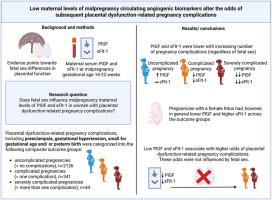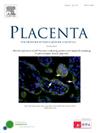妊娠中期母体循环血管生成生物标志物:与胎盘功能障碍相关妊娠并发症和胎儿性别的关联
IF 2.5
2区 医学
Q2 DEVELOPMENTAL BIOLOGY
引用次数: 0
摘要
胎盘功能因胎儿性别而异,胎盘功能障碍与不良妊娠结局相关。我们的目的是研究孕中期母体循环胎盘相关血管生成生物标志物和胎儿性别在胎盘功能障碍相关妊娠并发症中的作用。方法:预防儿童特应性皮炎和过敏的出生队列研究提供了2511例妊娠16-22周的孕妇血清。采用免疫分析法分析胎盘生长因子(PlGF)和可溶性膜样酪氨酸激酶-1 (sFlt-1)。妊娠并发症(n = 385)包括妊娠高血压、先兆子痫、早产和/或新生儿体重。结果:与男性胎儿相比,女性胎儿妊娠中期PlGF中位数较低,sFlt-1/PlGF比值中位数(四分位数范围)为:“无并发症”妊娠中位数为7.2(4.9-10.2)比6.4(4.3-9.0),“并发症”妊娠中位数为7.3(4.7-10.7)比6.4(4.5-9.0),“严重并发症”妊娠中位数为11.2(5.4-22.7)比5.9(4.8-13.4)。在PlGF最低胎次(调整优势比(aOR) 1.6, 95%可信区间(CI) 1.2-2.2)和sFlt-1 (aOR 1.4, 95% CI: 1.0-1.9)中,“任意数量妊娠并发症”的风险最高,而不受胎儿性别的影响(所有相互作用p < 0.05)。结论:妊娠中期循环胎盘相关血管生成生物标志物因胎儿性别和妊娠并发症而异。妊娠中期低PlGF和/或sFlt-1水平的妊娠并发症风险较高不受胎儿性别的影响。本文章由计算机程序翻译,如有差异,请以英文原文为准。

Midpregnancy maternal circulating angiogenic biomarkers: Associations with placental dysfunction-related pregnancy complications and fetal sex
Introduction
Placental function differs by fetal sex, and placental dysfunction is associated with adverse pregnancy outcomes. We aimed to investigate the role of midpregnancy maternal circulating placenta-associated angiogenic biomarkers and fetal sex in relation to placental dysfunction-related pregnancy complications.
Methods
The Preventing Atopic Dermatitis and Allergies in children birth cohort study provided maternal serum from 2511 pregnancies at gestational weeks 16–22. Placental growth factor (PlGF) and soluble fms-like tyrosine kinase-1 (sFlt-1) were analyzed by immunoassays. Pregnancy complications (n = 385) included gestational hypertension, preeclampsia, preterm delivery, and/or newborn weight <10th percentile; categorized as ‘uncomplicated’, ‘complicated’ and ‘severely complicated’ pregnancies by zero, one or two or more complications. The risk of ‘any number of pregnancy complications’ by biomarkers tertiles were assessed in multivariable logistic regression models with interaction analyses of fetal sex.
Results
Midpregnancy median PlGF was lower and sFlt-1 higher in pregnancies with a female versus a male fetus, with median (interquartile range) sFlt-1/PlGF-ratio being 7.2 (4.9–10.2) versus 6.4 (4.3–9.0) in ‘uncomplicated’, 7.3 (4.7–10.7) versus 6.4 (4.5–9.0) in ‘complicated’, and 11.2 (5.4–22.7) versus 5.9 (4.8–13.4) in ‘severely complicated’ pregnancies. The risks of ‘any number of pregnancy complications’ were highest in the lowest tertile of PlGF (adjusted odds ratio (aOR) 1.6, 95 % confidence interval (CI): 1.2–2.2) and sFlt-1 (aOR 1.4, 95 % CI: 1.0–1.9) without influence of fetal sex (all, pinteractions >0.05).
Conclusion
Circulating midpregnancy placenta-associated angiogenic biomarkers differed by fetal sex and pregnancy complications. The higher risk of pregnancy complications with low midpregnancy PlGF and/or sFlt-1 levels was not influenced by fetal sex.
求助全文
通过发布文献求助,成功后即可免费获取论文全文。
去求助
来源期刊

Placenta
医学-发育生物学
CiteScore
6.30
自引率
10.50%
发文量
391
审稿时长
78 days
期刊介绍:
Placenta publishes high-quality original articles and invited topical reviews on all aspects of human and animal placentation, and the interactions between the mother, the placenta and fetal development. Topics covered include evolution, development, genetics and epigenetics, stem cells, metabolism, transport, immunology, pathology, pharmacology, cell and molecular biology, and developmental programming. The Editors welcome studies on implantation and the endometrium, comparative placentation, the uterine and umbilical circulations, the relationship between fetal and placental development, clinical aspects of altered placental development or function, the placental membranes, the influence of paternal factors on placental development or function, and the assessment of biomarkers of placental disorders.
 求助内容:
求助内容: 应助结果提醒方式:
应助结果提醒方式:


